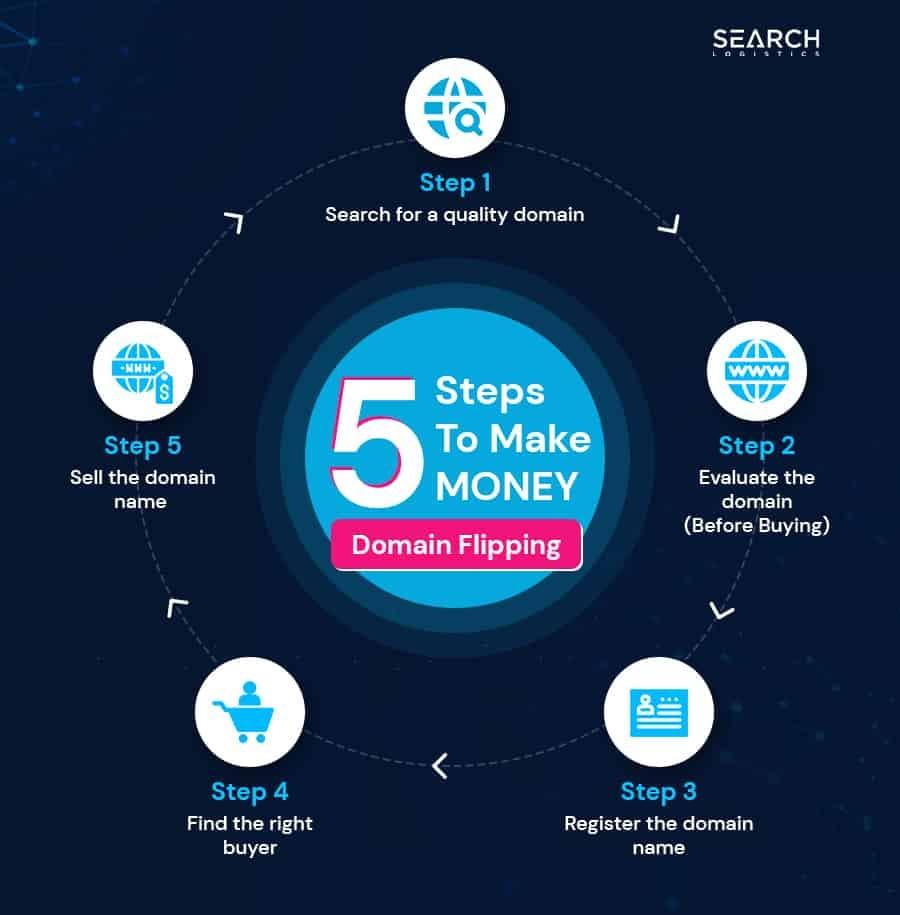Table of Contents
- Understanding the Basics of Domain Flipping
- Identifying Profitable Domain Opportunities
- Strategies for Valuing and Purchasing Domains
- Effective Marketing Techniques for Selling Domains
- Common Mistakes to Avoid in Domain Flipping
- Q&A
- The Way Forward


Understanding the Basics of Domain Flipping
At its core, domain flipping involves purchasing domain names at a lower price with the intent to sell them later at a profit. This lucrative practice hinges on a combination of creativity, market research, and strategic planning. Those who engage in this marketplace must be attuned to trends, understanding not just what might appeal to potential buyers but also which domain names hold inherent value. Factors such as keyword popularity, length, and brandability play significant roles in determining a domain’s worth.
Successful flippers often find themselves delving into various niches to identify emerging opportunities. They scour the web and communities, keeping an eye on trending keywords and newly popular phrases. The art of buying domains isn’t solely about picking names that sound good; it also involves an analytical approach. Considerations include:
- Market Demand: Is there a growing interest or need for the niche?
- SEO Value: How well does the domain perform in search engine rankings?
- Brand Potential: Does the name lend itself to easy branding?
A pivotal aspect of domain flipping is the resale process. After acquiring a domain, flippers typically enhance its value through a process known as “domain development,” which could include optimizing the site for search engines or even creating a basic content presence. When it’s time to sell, flippers can utilize various platforms and marketplaces that cater to domain sales, such as:
| Marketplace | Features |
|---|---|
| GoDaddy Auctions | Wide audience, bidding system |
| Sedo | International marketplace, escrow services |
| Afternic | Fast listings, extensive reach |
| Flippa | Includes websites and apps, user-friendly |


Identifying Profitable Domain Opportunities
When diving into the world of domain flipping, the key to success lies in recognizing which domain names hold the promise of strong profitability. The process often begins with thorough keyword research. Identifying trending keywords or phrases in your niche not only helps you find domain names with traffic potential but also boosts their desirability among buyers. Utilize tools like Google Trends, Ahrefs, or SEMrush to analyze search volume and competition for specific keywords, which can inform your choices significantly.
Another effective strategy is to concentrate on domain length and simplicity. Shorter domain names generally attract more interest due to their ease of remembrance and typeability. Look for names that are catchy, preferably consisting of just 1-3 words. Additionally, domains containing popular extensions, such as .com, .net, or .org, tend to hold more value. Keep an eye out for expired or expiring domains, as they might have existing traffic or backlinks that can enhance their worth:
| Domain Features | Why They Matter |
|---|---|
| Length | Shorter names are easier to remember and brand. |
| Keywords | Inclusion of relevant keywords improves SEO value. |
| Extension | Popular extensions are generally seen as more credible. |
| Traffic History | Domains with a traffic history can be more valuable right away. |
Lastly, consider the potential branding opportunities that a domain offers. Names that are unique, evocative, or allow for easy expansion into related niches can warrant higher prices. Think about the audience you want to target and what resonates with them. Check social media platforms and trademarks to ensure that the branding is not only available but also distinctive enough to stand out in the market. By paying attention to these aspects, you’ll be able to spot lucrative domain opportunities more efficiently.


Strategies for Valuing and Purchasing Domains
When diving into the world of domain flipping, understanding the art of valuing domains is crucial. The worth of a domain can vary widely based on several factors, including length, keyword relevance, and brandability. Shorter domains tend to hold more value due to their memorability and ease of typing. Additionally, domains that incorporate popular keywords related to thriving industries can significantly increase in value. Consequently, researching current market trends and analyzing comparable sales can aid in making informed purchases.
Once you have identified potential domains, the next step is to ascertain their purchase price and negotiate wisely. Many registrars offer domains at different price points, so comparing several platforms is essential. Utilize the following methods to strategize your purchasing process:
- Use Auctions: Platforms like GoDaddy Auctions or NameJet can offer great deals on premium domains that are up for bidding.
- Engage in Negotiation: When purchasing a domain directly from its owner, don’t be afraid to negotiate. A reasonable offer can often lead to a successful acquisition.
- Consider Expired Domains: Domains that are no longer in use can sometimes be picked up at minimal costs; however, they may have valuable backlinks intact, enhancing their SEO potential.
To further streamline your purchasing strategy, consider setting up a simple matrix to evaluate potential domains. This table can help you compare key factors that influence domain value:
| Domain Name | Length | Keywords | Price | Brandability |
|---|---|---|---|---|
| example.com | 7 | High | $2,500 | Yes |
| sampledomain.net | 15 | Medium | $850 | No |
| toptrendingtech.org | 15 | High | $1,200 | Yes |
In sum, combining thorough market research with strategic negotiation can enhance your domain flipping success. By understanding what makes a domain valuable, you can better identify lucrative opportunities and expand your portfolio.


Effective Marketing Techniques for Selling Domains
When it comes to positioning domains on the market, employing the right marketing strategies can significantly enhance your chances of making a sale. Start by creating an eye-catching landing page for each domain you wish to sell. This page should showcase the domain’s potential, including its keyword value, search traffic data, and possible use cases. An appealing design not only grabs attention but also builds trust with potential buyers.
Utilizing various online marketplaces can broaden your reach. Consider listing your domains on platforms such as:
- Sedo – A well-known marketplace for buying and selling premium domains.
- Flippa – Perfect for showcasing domains along with established websites.
- Afternic – Known for its extensive network and wide exposure to potential buyers.
- NamePros - A community-driven marketplace to connect with other domain investors.
Don’t overlook the power of social media marketing. Share your domains in relevant groups on platforms like Facebook, Twitter, and LinkedIn, where domain investors and entrepreneurs crowd. Additionally, consider utilizing email marketing to reach potential buyers directly. Create a concise email template that highlights the domain’s strengths and invites the recipient to consider it for their next project.
Common Mistakes to Avoid in Domain Flipping
Engaging in domain flipping can be a lucrative venture, but many newcomers stumble due to avoidable pitfalls. One common mistake is neglecting to conduct proper research before purchasing a domain. This includes failing to analyze its market potential, traffic statistics, and SEO rankings. It’s essential to use tools like Google Trends and SEO analysis platforms to assess if the domain you’re eyeing has lasting appeal. Buy domains that are not only trendy today but also have potential longevity in the market.
Another frequent misstep is pricing domains inaccurately. Many flippers either overestimate their domain’s value or undervalue it to make a quick sale. To avoid this, consider pricing strategies that reflect the domain’s length, keyword strength, and extension. It’s helpful to compare similar recent sales to understand better what buyers are willing to pay. Below is an example of how pricing can vary based on different attributes:
| Domain Type | Average Selling Price | Considerations |
|---|---|---|
| Short and Memorable | $2,000 – $10,000 | High demand, great for branding. |
| Keyword-Rich | $500 – $5,000 | Good for SEO but needs popularity. |
| New TLDs (Top-Level Domains) | $100 – $1,000 | Less exchangeable, can appeal to niche markets. |
one critical error is the lack of a solid marketing plan once the domain is acquired. Simply sitting on a domain is rarely enough to attract buyers. Utilize social media platforms and domain marketplaces to promote your listings effectively. Tools such as Sedó and Afternic can expand your reach considerably. It’s advisable to create engaging content that highlights the domain’s potential value, featuring engaging visuals and clear calls to action that entice potential buyers.
Q&A
Q&A: Understanding Domain Flipping
Q: What is domain flipping? A: Domain flipping is the process of buying domain names at a low price and then selling them at a higher price for profit. This practice takes advantage of the growing demand for unique and memorable web addresses, allowing savvy investors to generate income through strategic buying and selling.Q: How do I find valuable domains to flip? A: Identifying valuable domains often involves research and creativity. Look for keywords that are trending or have high search volume, consider short and memorable names, or explore expired domains that may have existing traffic. Tools like domain auctions, keyword research tools, and online marketplaces can help you in your hunt.
Q: What makes a domain name valuable? A: A domain name’s value can depend on several factors including its length, keyword relevance, memorability, brandability, and history. Domains that are short, easy to spell, and relevant to popular industries or niches tend to fetch higher prices. Furthermore, domains with a strong backlink profile or existing traffic can also be more desirable.
Q: What are the key steps in the domain flipping process? A: The domain flipping process generally involves a few key steps:
- Research: Identify trends and choose potentially valuable domains.
- Purchase: Buy the domains you’ve identified.
- Market: List your domains on marketplaces or reach out to potential buyers.
- Negotiate: Be prepared to negotiate on price.
- Sell: Finalize the sale and transfer the ownership.
Q: How much money do I need to start flipping domains? A: The amount you need to start flipping domains can vary widely. Some domains can be purchased for as little as $10, while premium domains can cost hundreds or thousands. A budget of a few hundred dollars is a good starting point, allowing you to acquire a few domains and test the waters.
Q: Are there risks involved in domain flipping? A: Yes, like any investment, domain flipping carries risks. The market can be unpredictable, and there’s no guarantee that you will sell a domain at a profit. Additionally, you may encounter scams or face challenges with domain transfer. Conducting thorough research and staying informed about market trends can mitigate some of these risks.
Q: How do I market my domains effectively? A: Marketing your domains can be done through various channels. Listing them on popular domain marketplaces like GoDaddy Auctions, Sedo, or Flippa is a good starting point. Additionally, leveraging social media, SEO strategies, and networking within online communities can help you reach potential buyers effectively.
Q: What are the most common mistakes new flippers make? A: Common mistakes include overpaying for domains due to hype, failing to conduct proper research on domain value, or neglecting to market their domains effectively. It’s crucial to approach domain flipping with patience and careful consideration.
Q: Can I make a full-time income from domain flipping? A: While it’s possible to make a full-time income from domain flipping, it typically requires significant expertise, knowledge of market trends, and consistent effort to build a profitable portfolio. Success varies from person to person, and many flippers start part-time before transitioning to full-time if they see sufficient returns.
Q: Where can I learn more about domain flipping? A: There are numerous resources available online, including blogs, forums, and tutorials dedicated to domain flipping. Websites like NamePros and DomainSherpa offer valuable insights and community support. Additionally, books and online courses can help you deepen your understanding of the domain flipping process.

